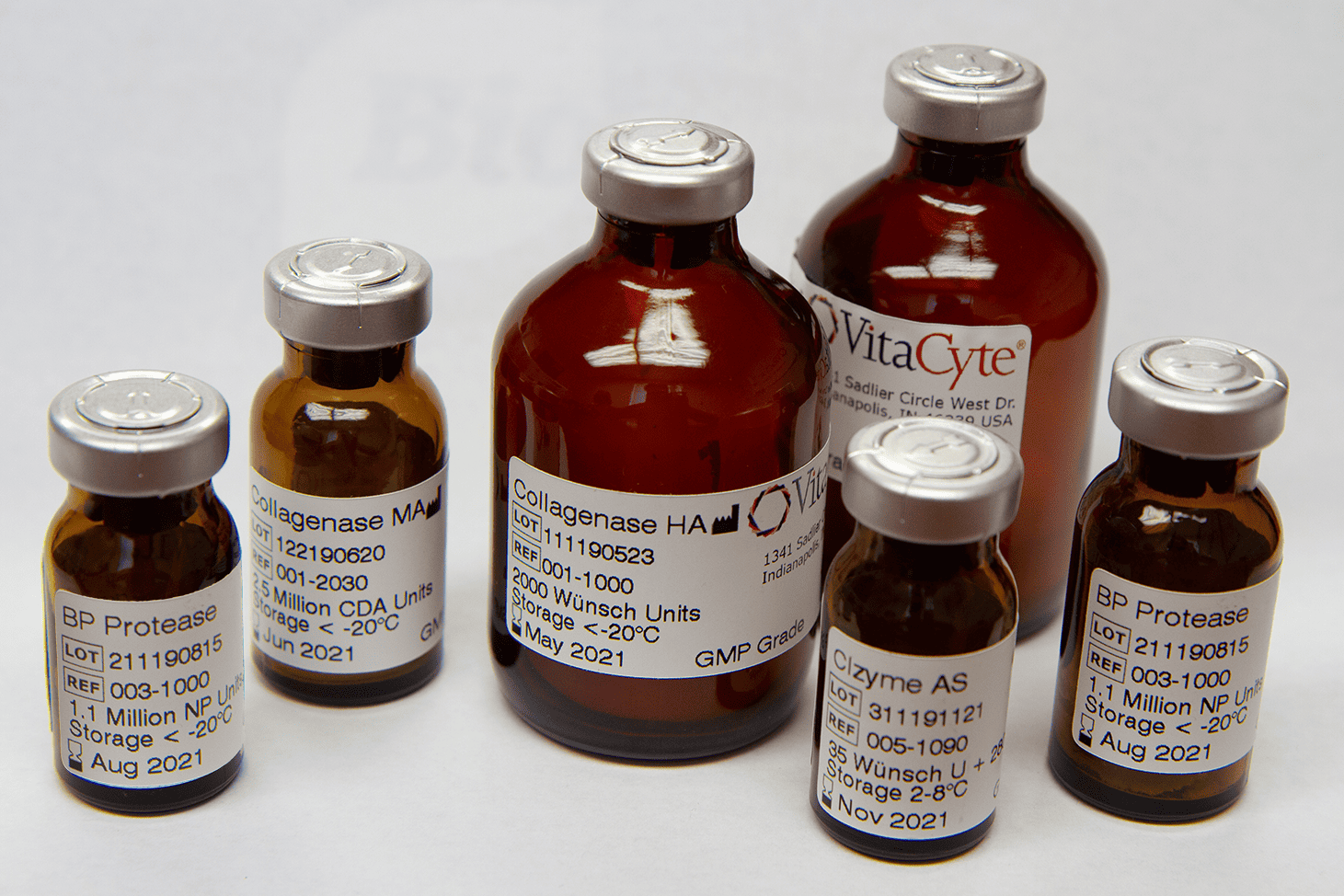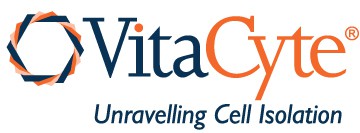
The original Liberase™ Purified Enzyme Blend product line was developed, manufactured, and sold in the U.S. in December 1994, by Boehringer Mannheim Biochemicals in Indianapolis. In 1995, the Liberase product was sold worldwide. The acquisition of Boehringer Manheim by Roche in 1998 and the subsequent transfer of the Liberase manufacturing to Germany in 2007, led to the development and launch of a modified Liberase product line in 2008. The table below compares the composition and packaging of the large pack size products in the Original and Modified Liberase product lines. The corresponding pairs of products are indicated by shaded or white rows. The Liberase CI product in the original product line is not listed because nearly all laboratories have discontinued the use of dogs for diabetes research.
Please note, the targeted mass of the proteases in the table below are the approximate dose of an equivalent product manufactured by VitaCyte, not the masses listed in the Roche product literature.
The mass of Thermolysin used in each bottle of the Modified Liberase products are different than those used in the Original Liberase product line. This difference is based on the extinction coefficients (A280/mg protein) used to calculate the Thermolysin protein concentration. For the Modified Liberase, the value was 1.76, whereas for the Original Liberase the value was 1.1.
To calculate equivalent enzyme activities between the Thermolysin products:
- Each mg of the Original Liberase or VitaCyte Thermolysin product is equivalent to 0.625 mg of the Modified Liberase Thermolysin product.
- Each mg of Modified Liberase Thermolysin is equivalent to 1.6 mg of the Original Liberase or VitaCyte Thermolysin product.
Similarly, VitaCyte’s BP Protease (a Dispase equivalent enzyme) has a 1.6 fold higher specific activity than the Dispase used in the Roche or Sigma products. This difference is accounted for in the table below.
Original Liberase1994-2008 |
Modified Liberase2008 to Present |
Targetmg purified collagenase per bottle large pack size |
Neutral Protease |
Targetmg VitaCyte’s purified proteases |
| Liberase HI | 485 | Thermolysin | ≈ 9.8 | |
| Liberase MTF | 500 | Thermolysin | ≈ 24 | |
| Liberase PI | 468 | Dispase | ≈ 19.6 | |
| Liberase DL | 50 | Dispase | ≈ 0.2 | |
| Liberase RI | 97 | Thermolysin | ≈ 1.7 | |
| Liberase TL | 50 | Thermolysin | ≈ 0.4 | |
| Blendzyme 1 | 50 | Dispase | ≈ 0.2 | |
| Liberase DH | 50 | Dispase | ||
| Blendzyme 2 | 50 | Thermolysin | ≈ 7.6 | |
| Liberase TL | 50 | Thermolysin | ≈ 0.4 | |
| Blendzyme 3 | 50 | Thermolysin | ≈ 15.3 | |
| Liberase TM | 50 | Thermolysin | ≈ 3.7 | |
| Blendzyme 4 | 50 | Thermolysin | ≈ 30.6 | |
| Liberase TH | 50 | Thermolysin | ≈ 7.5 | |
| Liberase MNP-S Non GMP | 35 | Thermolysin | ≈ 26.1 |
The only difference between VitaCyte’s purified Collagenase HA and the Roche MTF kit is the subclone used from the parent strain of Clostridium histolyticum and the methods used to purify the collagenases. The collagenase found in the Collagenase HA and Liberase MTF products are formulated as a 60:40 class I:class II collagenase ratio.
The table below shows VitaCyte’s broad line of purified collagenase products. In addition to selling Collagenase HA, VitaCyte sells a lower cost purified collagenase, Collagenase Gold, and animal origin free recombinant C. histolyticum collagenase for human islet isolation (rCollagenase HI). Collagenase Gold is as pure of the Collagenase HA or MTF products, but this lower cost product contains approximately a 75:25 class I:class II ratio.[1] This non GMP grade, research product performs as well as other purified collagenase products for human islet isolation.[1,2] The Collagenase Gold Plus product is a GMP Grade version of the same product.
The formulation of rCollagenase HI was derived from a design of experiment study performed at the University of Minnesota to determine the effect of class I and class II collagenase dose on human islet isolation.[3] The formulation was the mid-point of the four different doses used in the study. Recent work at the University of Alberta in Edmonton has shown that human islets isolated with rCollagenase HI and BP Protease gave significantly higher stimulation indices in glucose stimulated insulin release studies, higher recovery of islets after culture that translated to higher numbers of islets used in the transplant procedure when compared to islets isolated with natural purified collagenase (MTF kit or Collagenase HA and thermolysin).[4]
The table below lists the VitaCyte products that can be used in place of Roche’s Liberase products. The only products that are not GMP Grade are Collagenase Gold and CIzyme RI. BP Protease is equivalent to Dispase.
Product |
Catalog Number |
Pack Size |
Approximate Massmg |
Manufacturing Grade |
| Collagenase HA | 001-1000 | 2000 Wunsch U | 450 | GMP Grade |
| Collagenase HA | 001-1050 | 200 Wunsch U | 45 | GMP Grade |
| Collagenase MA | 001-2020 | 1100 Wunsch U | 250 | GMP Grade |
| Collagenase MA | 001-2030 | 2.5 million CDA U | 100 | GMP Grade |
| Collagenase Gold | 011-1060 | 1 g | 440 | Research Use Only |
| Collagenase Gold Plus | 011-2000 | ≥ 1500 FALGPA U | 450 | GMP Grade |
| Thermolysin | 002-3000 | 6 mg | 6 | AOF, GMP Grade |
| BP Protease | 003-1000 | 1.1 million NPA U | 8 | AOF, GMP Grade |
| BP Protease | 003-2000 | 2.3 million NPA U | 16 | AOF, GMP Grade |
| rCollagenase HI | 001-4010 | 1600 Wunsch U | 380 | AOF, GMP Grade |
| CIzyme RI | 005-1030 | 375K CDA U/ 275K NP U | 16 | Research Use Only |
| CIzyme AS | 005-1090 | 35 Wunsch U 280K NP U | 9 | GMP Grade |
For any technical questions Contact Us.
References
[1] Loganathan G, Hughes MG, Szot GL, et al. (2019) Low Cost, Enriched Collagenase-Purified Protease Enzyme Mixtures Successfully Used for Human Islet Isolation. OBM Transplantation;3(2):14; doi:10.21926/obm.transplant.1902064.
[2] Khiatah B, Tucker A, Chen KT, et al. (2018) Evaluation of collagenase gold plus BP protease in isolating islets from human pancreata. Islets. 10: 51-59.
[3] Appakalai B, Green M, Breite A, et al. (2015). Identifying Effective Enzyme Activity Targets for Recombinant Class I and Class II Collagenase for Successful Human Islet Isolation. Transplantation Direct. 2. 1. 10.1097/TXD.0000000000000563.
[4] O”Gorman D, Kin T, Rosichuk S, et al. Evaluation of a low dose recombinant collagenase and BP Protease for clinical islet transplantation. (2021) IPITA abstract 306.4. https://journals.lww.com/transplantjournal/Fulltext/2021/12001/306_4__Evaluation_of_a_Low_Dose_Recombinant.30.aspx
